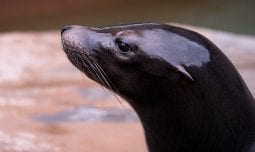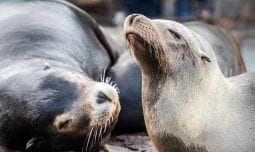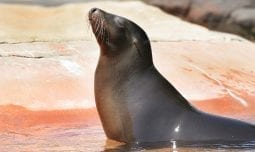Classification
Class Mammalia
Order Carnivora
Family Otariidae
Genus Zalophus
Species californianus
Habitat & Range
They live along the coast and off-shore islands. They have been found up to 75 miles out in the ocean. They may also travel up rivers that feed into an ocean.
California sea lions are found along the west coast of North America from British Columbia to Baja California and in the Galapagos Islands, the Sea of Cortez and the Gulf of Alaska.

California Sea Lion
Zalophus californianus
California sea lions are marine mammals with limbs that are modified as flippers. When swimming, sea lions are propelled by their large front flippers while the rear flippers act like rudders that help steer. Flippers enable sea lions to swim long distances and dive deep to find food. Sea lions are also adapted for movement on land! Amazingly they can rotate their rear flippers forward for improved mobility on land.
Adaptations
- Sea lions have small external ear flaps and can hear as well as humans on land. In the water, their hearing is exceptional – they can hear higher frequency sounds than humans.
- California sea lions are marine mammals with limbs that are modified as flippers. When swimming, sea lions are propelled by their large front flippers while the rear flippers act like rudders that help steer. Flippers enable sea lions to swim long distances and dive deep to find food. Sea lions are also adapted for movement on land. They can rotate their rear flippers forward for improved mobility on land.
- Sea lions have streamlined bodies that enable them to swim at speeds of 25 to 30 miles per hour. When submerged for long periods (5-10 minutes), a sea lion will decrease its heart beat to reduce the amount of oxygen needed.
Physical Description
- On average, California sea lions are 5-7 feet long.
- Males can grow to weigh over 800 pounds (390 kg). Females are significantly smaller growing to only around 220 pounds (100 kg)
- California sea lions have a torpedo-shaped body with short dark brown to light brown fur.
- By the age of five, males develop a distinct bump, called the sagittal crest, on the top of their heads and lighter brown to tan fur giving the appearance of a mane.
- Sea lions look quite different than seals. Sea lions are solid in color and are quite mobile on land, using their larger front flippers to maneuver.
Diet
What Does It Eat?
In the wild: Fish, octopus, squid, crab, clams and lobsters
At the zoo: Capelin, herring and mackerel supplemented with vitamins and minerals
What Eats It?
California sea lions are preyed on by sharks and orcas.
Social Organization
California sea lions are highly social animals gathering in large groups called “colonies”. They often rest closely packed together on land or float together in the water. During breeding season, adult males called bulls, battle for dominance and establish territories. Each male attracts a group of up to 20 females to breed with. Before giving birth, females gather at a rookery, a beach or rocky outcropping.
Life Cycle
After a gestation of nine to 11 months females give birth to a single pup born fully furred with eyes open. Newborn pups are able to move around within 30 minutes after birth. The mother stays with the pup for up to six days before venturing back into the ocean to feed. While mothers are gone, pups gather together to play. Pups and mothers identify each other by sound and smell. Pups nurse for a year even though they can begin to digest fish at three months. Under their mother’s protection, the pups will begin to venture into deeper water to feed. They leave their mother after one year. Females breed again about 21 days after giving birth and can delay implantation of the fetus for up to three months. Sea lions live from 12-30 years in the wild.
Collection Connection
- Six California sea lions live at Denver Zoo. Three of these animals were rescued by The Pacific Marine Mammal Center in Laguna Beach, California. When they were not able to be rereleased successfully, Nick, Maverick and Duke came to live at Denver Zoo.
- Nick is the largest sea lion. He was born June 14, 2007. Because he was rescued, he came to the Zoo when he was less than a year old. He has the loudest bark and you can often hear him when visiting the Zoo.
- Duke was born around June 15, 2014. Denver Zoo is not sure of his birthday because he was rescued. He is always very focused when training with staff.
- Maverick was also born around June 15, 2014. Maverick loves to learn and has an orange tag attached to one of his flippers.
- Luci is the oldest sea lion. She was born June 17, 2001. She participates well in training.
- Ady was born June 13, 2015. Ady and Gunnison are Luci and Nick’s offspring. She is energetic and spends a lot of time near her dad, Nick.
- Gunnison is the youngest, born June 11, 2015. He spends a lot of time with Duke.
Conservation Status
IUCN Status: Least Concern
In the United States, California sea lions are protected by the Marine Mammal Act of 1972. The populations of this species have been increasing steadily since 1975 . As a marine species, sea lions are especially sensitive to climate change and pollution.

Download the App!
Get the FREE Denver Zoo app today, and be a pro the next time you visit the Zoo. You’ll get access to the Zoo map, daily activities and schedules, animal facts, and more. You can even load your membership card onto the app for additional convenience. It puts everything you need for an amazing Zoo experience right into the palm of your hand!






